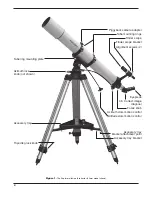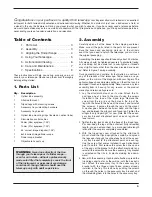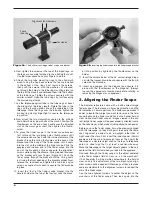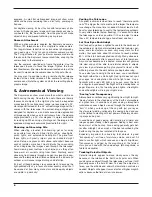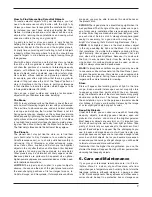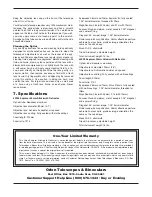
7
How to Find interesting Celestial objects
To locate celestial objects with your telescope, you first
need to become reasonably familiar with the night sky.
Unless you know how to recognize the constellation Orion,
for instance, you won’t have much luck locating the Orion
Nebula. A simple planisphere, or star wheel, can be a valu-
able tool for learning the constellations and seeing which
ones are visible in the sky on a given night.
A good star chart or atlas can come in very handy for
helping find objects among the dizzying multitude of stars
overhead. Except for the Moon and the brighter planets,
it’s pretty time consuming and frustrating to hunt for objects
randomly, without knowing where to look. You should have
specific targets in mind before you begin looking through
the eyepiece.
Start with a basic star atlas, one that shows stars no fainter
than 5th or 6th magnitude. In addition to stars, the atlas
will show the positions of a number of interesting deep-sky
objects, with different symbols representing the different
types of objects, such as galaxies, open star clusters, glob-
ular clusters, diffuse nebulas, and planetary nebulas. So,
for example, your atlas might show that there is a globular
cluster sitting just above the lid of the “Teapot” pattern of
stars in Sagittarius. You then know to point your telescope
in that direction to locate the cluster, which happens to be
6.9-magnitude Messier 28 (M28).
You can see a great number and variety of astronomical
objects with your Explorer telescope, including:
the Moon
With its rocky, cratered surface, the Moon is one of the easi-
est and most interesting targets to view with your telescope.
The best time to observe our one and only natural satellite
is during a partial phase, that is, when the Moon is not full.
During partial phases, shadows on the surface reveal more
detail, especially right along the border between the dark and
light portions of the disk (called the “terminator”). A full Moon
is too bright and devoid of surface shadows to yield a pleas-
ing view. Use a Moon filter to dim the Moon for a better view.
The filter simply threads onto the bottom of the eyepiece.
the Planets
The planets don’t stay put like the stars, so to find them
you should refer to Sky Calendar at our website (www.
OrionTelescopes.com), or to charts published monthly in
Astronomy, Sky & Telescope, or other astronomy maga-
zines. Venus, Mars, Jupiter, and Saturn are the brightest
objects in the sky after the Sun and the Moon. Your Explorer
is capable of showing you these planets in some detail.
Other planets may be visible but will likely appear starlike.
Because planets are quite small in apparent size, optional
higher-power eyepieces are recommended and often need-
ed for detailed observations.
JUPITER The largest planet, Jupiter, is a great subject to
observe. You can see the disk of the giant planet and watch
the ever-changing positions of its four largest moons, Io,
Callisto, Europa, and Ganymede. If atmospheric conditions
are good, you may be able to resolve thin cloud bands on
the planet’s disk.
SATURN The ringed planet is a breathtaking sight when it is
well positioned. The tilt angle of the rings varies over a peri-
od of many years; sometimes they are seen edge-on, while
at other times they are broadside and look like giant “ears”
on each side of Saturn’s disk. A steady atmosphere (good
seeing) is necessary for a good view. You may see a tiny,
bright “star” close by; that’s Saturn’s brightest moon, Titan.
VENUS At its brightest, Venus is the most luminous object
in the sky, excluding the Sun and the Moon. It is so bright
that sometimes it is visible to the naked eye during full day-
light! Ironically, Venus appears as a thin crescent, not a full
disk, when at its peak brightness. Because it is so close to
the Sun, it never wanders too far from the morning or eve-
ning horizon. No surface markings can be seen on Venus,
which is always shrouded in dense clouds.
MARS If atmospheric conditions are good, you may be able
to see some subtle surface detail on the Red Planet, possi-
bly even the polar ice cap. Mars makes a close approach to
Earth every two years; during those approaches its disk is
larger and thus more favorable for viewing.
Stars
Stars will appear like twinkling points of light in the tele-
scope. Even powerful telescopes cannot magnify stars
to appear as more than points of light. You can, however,
enjoy the different colors of the stars and locate many pretty
double and multiple stars. The famous “Double-Double” in
the constellation Lyra and the gorgeous two-color double
star Albireo in Cygnus are favorites. Defocusing the image
of a star slightly can help bring out its color.
Deep-Sky objects
Under dark skies, you can observe a wealth of fascinating
deep-sky objects, including gaseous nebulas, open and
globular star clusters, and some of the brighter galaxies.
Most deep-sky objects are very faint, so it is important you
find an observing site well away from light pollution. Take
plenty of time to let your eyes adapt to the darkness. Don’t
expect these subjects to appear like the photographs you
see in books and magazines; most will look like dim gray
smudges because our eyes are not sensitive enough to see
color in such faint objects. But as you become more experi-
enced and your observing skills get sharper, you will be able
to ferret out more and more subtle details.
Remember that the higher the magnification you use, the
dimmer the image will appear. So stick with low powers when
observing faint deep-sky objects.
6. Care and Maintenance
If you give your telescope reasonable care, it will last a
lifetime. Store it in a clean, dry, dust-free place, safe from
rapid changes in temperature and humidity. Do not store the
telescope outdoors, although storage in a garage or shed
is OK. Small components like eyepieces and other acces-
sories should be kept in a protective box or storage case.


